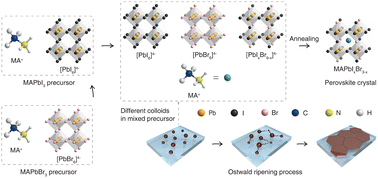Efficiency improvement of semi-transparent perovskite solar cells via crystallinity enhancement†
Abstract
A wide bandgap makes methylammonium lead iodide (MAPbI3) a suitable candidate for semi-transparent perovskite solar cells (ST-PSCs). Moreover, ultra-thin perovskite films prepared to achieve semi-transparency compromise the quality of films and damage much of the photovoltaic performance. Herein, a straightforward crystallization strategy is developed for fabricating MAPb(IxBr1−x)3 perovskite films. High-quality ultra-thin films are achieved through controlled nucleation and growth of introducing methylammonium lead bromide (MAPbBr3) components in the form of a precursor solution as a whole, which can change the variety of colloids serving as nucleation sites during crystallization, simultaneously improving the crystallinity of films and reducing the loss of photovoltaic performance caused by defects. Thus, an ST-PSC with efficiency exceeding 18% was obtained, and the average visible transmittance (AVT) of the perovskite film reached 26.23% by introducing 4% MAPbBr3. This work demonstrates a simple and convenient method to prepare high-quality perovskite films and reveals the intrinsic reasons for improving the crystallinity of perovskite films, which paves the way for the evolution of high-performance tandem cells using efficient ST-PSCs as top cells or integrating them with buildings.



 Please wait while we load your content...
Please wait while we load your content...